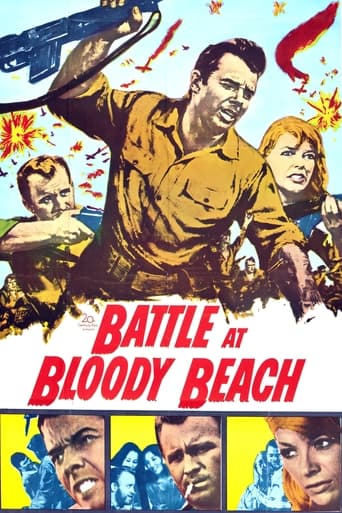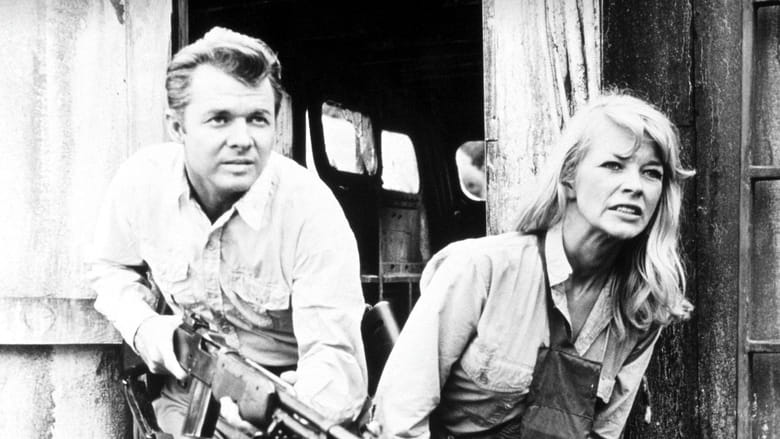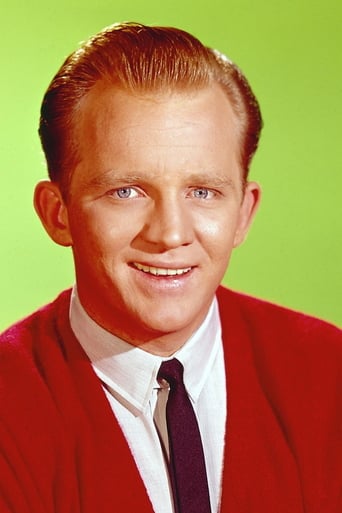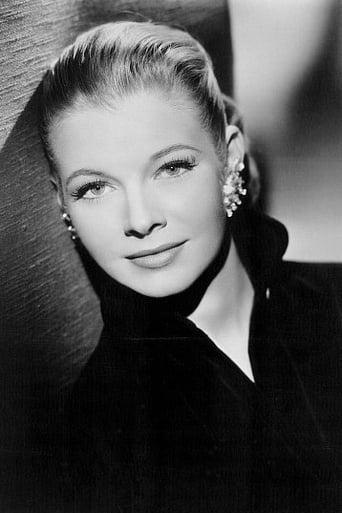

Battle at Bloody Beach (1961)
This is only the second Audie Murphy movie set in WWII after his autobiographical "To Hell and Back." Here Murphy steps out of his usual kid-Western role to play a civilian working for the Navy helping supply guerilla insurgents in the Philippines. His sole motive is not politics nor bravery, but to find his bride from whom he was separated during the Japanese invasion two years before
Watch Trailer
Cast
Reviews
I love this movie so much
Overrated and overhyped
A waste of 90 minutes of my life
It’s fine. It's literally the definition of a fine movie. You’ve seen it before, you know every beat and outcome before the characters even do. Only question is how much escapism you’re looking for.
Audie Murphy (Craig Benson), Gary Crosby (Marty Sackler), Dolores Michaels (Ruth Benson), Alejandro Rey (Julio Fontana), Marjorie Stapp (Caroline Pelham), Barry Atwater (Jeff Pelham), E.J. Andre (Dr Van Bart), Dale Ishimoto (Blanco), Miriam Colon (Nahni), Pilar Seurat (Camota), Lillian Bronson (Delia Ellis), William Mims (M'Keever), Ivan Dixon (Tiger Blair), Kevin Brodie (Timmy Thompson), Sara Anderson (Mrs Thompson), Lloyd Kino (Japanese lieutenant).Director: HERBERT COLEMAN. Screenplay: Richard Maibaum, Willard Willingham. Based on a story by Richard Maibaum. Photography: Kenneth Peach. Supervising film editor: Jodie Copelan. Music composed and conducted by Henry Vars. Art director: John Mansbridge. Set decorations: Harry Reif. Wardrobe: Robert Olivas. Make-up: Vincent Romaine. Script supervisor: George Rutter. Property master: Wilbur L. Russell. Photographed in black-and-white CinemaScope. CinemaScope lenses by Bausch & Lomb. Production supervisor: Harold E. Knox. Assistant director: Francisco Day. Sound editor: Jack Cornall. Sound: Jack Solomon, Frank McWhorter. Sound facilities: Glen Glenn Sound Company. Producer: Richard Maibaum. Executive producer: Robert L. Lippert. An API Production for 20th Century-Fox. 2nd assistant director: George Batcheller. Made with the co- operation of the United States Defense Department and the United States Navy.Copyright 1 June 1961 by Associated Producers, Inc. New York opening at neighborhood theaters: 16 August 1961. U.S. release: June 1961. U.K. release: 23 July 1961. Never theatrically released in Australia. 80 minutes.U.K. release title: BATTLE ON THE BEACH.SYNOPSIS: During the Jap invasion of the Philippines, an American aids the guerrillas.VIEWER'S GUIDE: Not suitable for children.COMMENT: Yet another of those U.S.-Filipino war pics, this one is more routine than most. The direction only comes to life during the climactic battle. The rest of the film is pretty dull sledding, despite a few brief bursts of action and a heroine who tends to be more sultry than the script requires.OTHER VIEWS: Set during the Japanese occupation of the Philippines, with Audie Murphy involved in a distinctly uneasy blend of marital problems and melodramatic heroics. The director handles the action scenes competently but both he and his cast are at the mercy of the unconvincing script when it comes to the personal affairs of the characters. It all rings much too hollow and the result is an overloaded melodramatic hodge-podge. — E.V.D.
BATTLE AT BLOODY BEACH 1961 This WW2 film has Audie Murphy in the starring role. The action takes place on an unnamed island in the Philippines. Murphy, who had been working in the Islands at the time of the Japanese Invasion, was lucky enough to have escaped. He however was unable to save his wife in all the confusion. He is now helping the US supply various Philippine resistance groups with arms and ammo. These are landed at night by submarine. Murphy uses these trips to spend time looking for his lost wife who he is sure is still alive.This time there is trouble right from the get go. When Murphy hits the beach to meet his underground contact, Gary Crosby, he is jumped by a pair of patrolling Japanese soldiers. There is a brisk bit of hand to hand before Murphy and Crosby dispose of the Japanese. They hide the corpses and hightail it into the hills to Crosby's jungle shack. That is where Crosby has his radio.At the shack Murphy meets several members of Crosby's band of guerrillas. One of this group, Dale Isimoto, leads Murphy to a meeting with William Mims. Mims is an American leading his own bunch of men. They want Murphy to supply them with arms so they can fight the Japanese. This does not happen as Murphy discovers that Mims and his men are simply bandits robbing the locals.Arriving on the scene now is a genuine guerrilla leader, Alejandro Rey. Rey's men and Mims bunch engage in a quick and bloody battle with Rey's men winning. With Rey, Murphy finds his wife, Dolores Michaels. While Murphy is happy as pie with the reunion, Michaels is not. Thinking Murphy had been killed in the invasion, Michaels and Rey have been doing a bit of horizontal Mambo. Michaels now loves Rey.Rey brings in all the Americans who have been hiding in the hills so they can be lifted by the submarine. Murphy agrees to this and will give Rey the rifles etc that he brought. Murphy is somewhat surprised when Michaels tells him she is staying with Rey.Anyways, before the civilians can be taken out to the sub a large force of Japanese interrupt the proceedings. The Americans hide out in a wrecked ship on the beach and manage to fight off the Japanese assault. The Japanese send for a couple of mortars and begin to plaster the ship killing off the Americans one by one. It is only the last minute arrival of Rey's men that rout the Nipponese and save the day. Michaels has now decided that she does still love Murphy and will leave with him.This is at best an average war film. It suffers from some not so good acting by the supporting cast as well as slipshod editing and direction. Murphy, Michaels and Crosby are however decent and do their best.The director, Herbert Colman had worked with Murphy on the western POSSE FROM HELL. Colman had been a second unit director on 5 Hitchcock films including VERTIGO, TO CATCH A THIEF and REAR WINDOW. The man would soon end up working on the TV series, GILLIGAN'S ISLAND.The story and screenplay, which should have been better, was by Hollywood veteran, Richard Maibaum. Maibaum wrote the story or screenplay for, THE GREAT GATSBY, I WANTED WINGS, O.S.S., THE RED BERET, HELL BELOW ZERO, RANSOM, GOLDFINGER, DR NO, FROM Russia WITH LOVE, THUNDERBALL and THE MAN WITH THE GOLDEN GUN.Look close and you can see Ivan Dixon in an early role. Dixon would become famous as one of men in the 1960's TV hit, HOGAN'S HEROES.
What is there to add regarding this cinematic failure? It has a lot to dislike, including it's terribly written script; vacant, dull and useless film space, and lack of convincing combat. Without a doubt, it is one of Audie Murphy's worst choices -- to act in this horribly boring, low budget flick.Just why do well known actors do this? Maybe Audie was in dire need of the little cash this part provided him. I tell myself, had I known him personally, that I could have taught him how to manage his finances and to resist gambling. He could have been amazingly well situated, free from the need to pick up the spare change such cheap diversions earned him; but, we must not forget, he fought an inward battle as well with PTSD, which can halt a man's perspective of his entire history: past, present and future. He will do anything to attempt to rid himself of his thoughts when he's alone.Still, we continue to hold Audie Murphy dear, and are always willing to give him praise and honor no matter his choices. Why? Because he truly was a hero. An inwardly torn one, for sure, yet still a notable figure.Had someone in his life known more, maybe that person could have helped him, saved him from his own destructive thoughts and behaviors. Unfortunately, so little was truly understood of post traumatic stress disorder (PTSD) in those days, which, even today, men and women, victims of having experienced life in harm's way, continue to battle within themselves.After working nearly thirty years in a VA hospital, I've seen men return home with it. Relationships suffer, insomnia takes a toll, and poor habits and addictions latch hold. Withdrawing from the world may also set in. Whatever the symptom, these men deserve our lasting respect and honor.
I've often wondered how WWII action flicks played with audiences of the early 1960s--did movie-goers still feel patriotic about them or was there a sense that it was time to move on from stories pitting Americans against the ruthless Japanese? Here, married Audie Murphy sails the Pacific searching for his missing spouse, eventually finding her on an island in the Phillipines along with a band of Americans and Polynesians being threatened by the relentless Japanese army. In Audie's absence, his Mrs. has taken up the guerrilla fighter's cause--and with thin-but-swarthy soldier Alejandro Rey!--but when they're surrounded by bloodthirsty Japs, the group must put aside their differences long enough to survive. Typical war movie, though with the added pleasure of some campy action and not-bad black-and-white cinematography. Murphy was never much of an actor, but here his stolid manner is a relief from all the hysteria. The director shows absolutely no sympathy for the dead or the dying (on either side), but the central romantic situation is handled with surprising skill and the climactic battle, though hurt by choppy editing, is nevertheless involving. ** from ****


